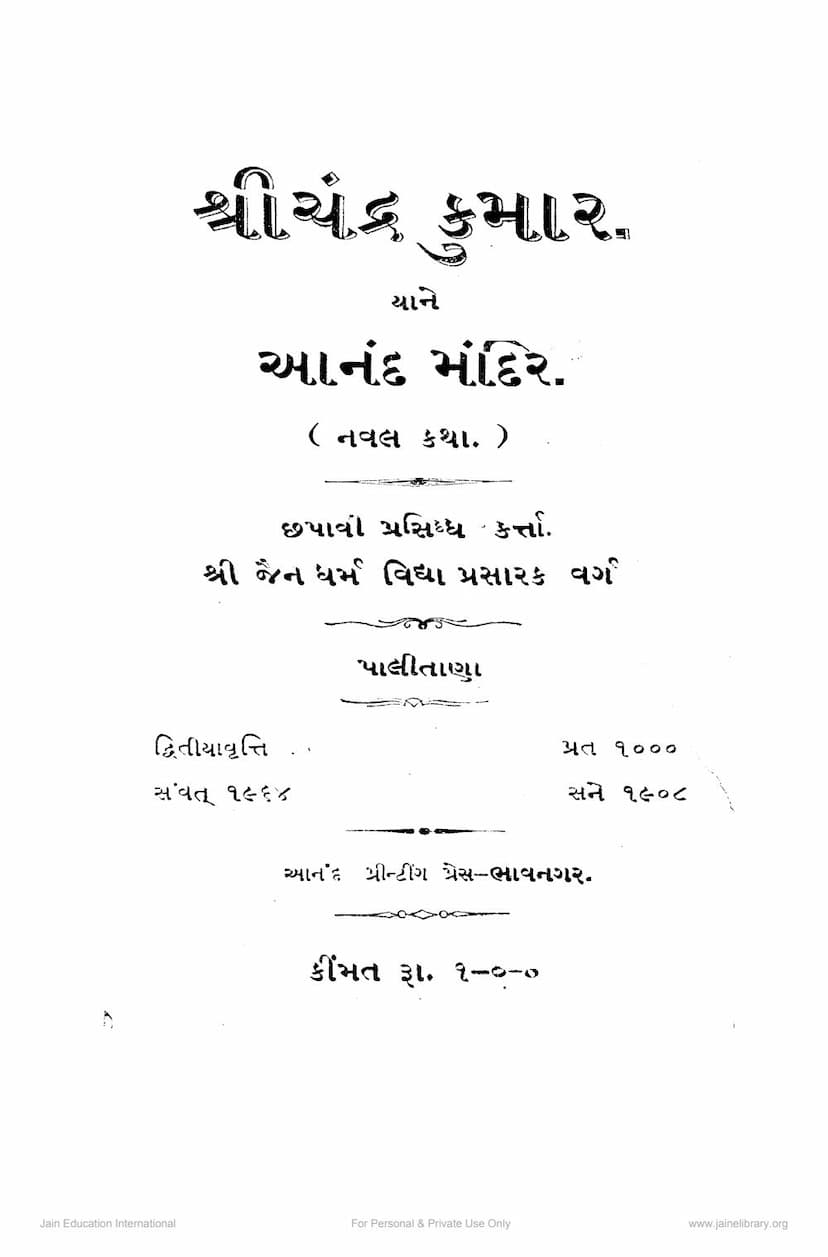Shreechand Kumar Yane Anand Mandir
Added to library: September 2, 2025

Summary
Here's a comprehensive summary of the Jain text "Shreechand Kumar yane Anand Mandir" in English:
Book Title: Shreechand Kumar yane Anand Mandir (Shreechand Kumar, meaning the Temple of Joy) Author(s): Jain Dharm Vidya Prasarak Sabha Palitana Publisher: Jain Dharm Vidya Prasarak Varg Catalog Link: https://jainqq.org/explore/005580/1
Overview:
"Shreechand Kumar yane Anand Mandir" is a novel written in Gujarati, published by Shri Jain Dharm Vidya Prasarak Varg from Palitana. This summary is based on the provided text, which appears to be the second edition from Samvat 1964 (1908 AD). The book is a narrative focused on the life and deeds of Shreechand Kumar, a virtuous individual, and aims to illustrate Jain principles and moral conduct, interspersed with elements of adventure, romance, and spiritual teachings.
Key Themes and Narrative Arc (based on chapter titles and summaries):
The story appears to be a classical Indian novel with a strong Jain philosophical undertone. It follows the life of a protagonist, likely Shreechand Kumar, who undergoes various experiences that shape his character and ultimately lead him towards spiritual enlightenment. The narrative is structured around numerous chapters, each detailing specific events, lessons, or character developments.
Summary based on Chapter Progression (Extrapolated from the table of contents):
The novel begins by introducing an unknown traveler and the setting of the story. We are then introduced to King Deepchandra, followed by the vision of the princess, the position of the chief queen, and the defeat of the king in some context. The narrative progresses through the advice of the mother, the account of an astrologer, the dream of Suryavati, and then delves into the story of Jayakumar's deception.
The central character, Shreechand Kumar, is introduced with his birth and subsequent development. The story seems to involve the separation of the prince, Pratap Singh's second victory, Shreechand's childhood, and a miracle in the garden. The theme of determination or resolution is also present.
The narrative explores concepts like Kapur's deception, Shreechand Kumar's birth, and Shreechand's childhood. It moves through Jaikumar's trickery, the prince's separation, Pratap Singh's second victory, and Shreechand's childhood. Events include wonders in the garden, predetermination or destiny, residence in the house of learning, Shreechand Kumar's reward, horse testing, the dark maiden, Tilakmanjari, preparation for the Swayamvar, Radha's archery, and Shreechand's congratulations.
The story involves upheaval in Tilakpur, the preaching of a great sage, the dual nature of Chandrakala and Padmini, Chandrakala's infatuation, the final marriage, the display of cleverness, the journey, the unveiling of the inner self, the mantra pill, the ox cart, the meeting of the four noble men, the yogini, the temple of the eye, the change of attire, and the trouble of Madanpal.
Further events include Shreechand in the cave, religious discourse, Tripuranan Yogi, theft of divine property and Shakravatar Tirtha, the capture of the mind, and Shreechand's salvation.
The later chapters deal with Shreechand's childhood, the miracle in the garden, determination or resolution, the prince's separation, Pratap Singh's second victory, and the mother's advice. The narrative continues with the account of an astrologer, Suryavati's dream, and the defeat of the first king.
The story progresses through Shreechand's education, horse testing, the dark maiden, Tilakmanjari, preparations for the Swayamvar, and Radha's archery. It also includes Shreechand's gratitude, upheaval in Tilakpur, the great sage's discourse, Chandrakala and Padmini, Chandrakala's infatuation, the final marriage, the journey, the revelation of the inner self, the mantra pill, and the ox cart.
The narrative also touches upon the meeting of four great men, the yogini, the temple of the eye, the change of attire, Madanpal's plight, Shreechand in the cave, religious discourse, Tripuranan Yogi, divine property and Shakravatar Tirtha, and the capture of the mind.
Finally, the story moves towards Shreechand's Kevali (omniscient) state, the dispelling of obstacles, and the conclusion of his reign.
Specific Plot Points and Character Arcs:
- Shreechand Kumar: The central protagonist, who undergoes a journey of learning, faces challenges, demonstrates virtues like courage, intelligence, and adherence to dharma. His life story seems to encompass many significant events, including his birth, childhood, education, marriage, and eventual spiritual attainment.
- Pratap Singh: A king, likely from Kushashtali, who is presented as a virtuous and powerful ruler. His interactions with Shreechand Kumar seem pivotal.
- Shreechand's Royal Marriage: The narrative seems to lead towards Shreechand Kumar marrying a princess, possibly Suryavati or Chandrakala, and his rise to a position of prominence.
- Confrontations and Victories: The story includes instances of Shreechand overcoming obstacles, such as defeating enemies and dealing with deceptive characters like Jayakumar and the pillapati.
- Spiritual Journey: The text hints at Shreechand Kumar's eventual spiritual enlightenment, possibly through the teachings of great sages and munis.
- Moral and Religious Lessons: Throughout the narrative, Jain principles like ahimsa (non-violence), daya (compassion), satya (truthfulness), and adherence to vows are likely emphasized. The importance of good conduct, respect for elders, and spiritual practices are evident from the chapter titles.
- The Role of Destiny and Fortune: Chapters like "Nidan or Niyanu" (Predetermination or Resolution) suggest themes of karma and destiny playing a role in the characters' lives.
- Family and Relationships: The story involves familial relationships, including the influence of mothers, fatherly advice, and the dynamics within the royal court.
Publication Details:
- Second Edition: Published in Samvat 1964 (1908 AD).
- Price: Rs. 1-9.
- Quantity Printed: 1000 copies.
Overall Message:
"Shreechand Kumar yane Anand Mandir" appears to be an exemplary Jain narrative, offering moral guidance, illustrating the principles of righteous living, and depicting the protagonist's journey from worldly pursuits to spiritual realization. The story likely emphasizes the importance of virtuous actions, adherence to Jain ethics, and the eventual triumph of good over evil, ultimately leading to a state of lasting joy and peace (Anand Mandir).